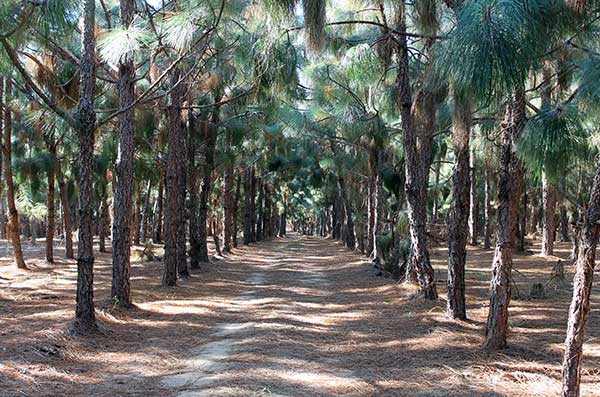Longleaf Pine A Natural Treasure For MGA
Author: Sheron Smith
Posted: Monday, November 22, 2021 12:00 AM
Categories:
Students | Pressroom | Faculty/Staff | In the News
Macon, GA

One of the stands of longleaf pine on MGA's Macon Campus.
Along outer edges of the Macon and Cochran campuses of Middle Georgia State University (MGA), the tree that once dominated the South is making a comeback.
Stands of longleaf pine the University planted just over a decade ago tower above 40 acres of the Cochran Campus near NeSmith Field, where the Knights play their home soccer and club football games. On the Macon Campus’s far west end, in areas also totaling about 40 acres, the almost perfectly straight trees bound portions of the Georgia Premier cross-country course.
Located in parts of the campuses that, outside athletic or special events, are less accessible to the MGA community and general public, the tree stands nevertheless provide considerable visual and atmospheric appeal – and this is while they still are in the early years of potentially very long lifespans. For many people, stepping into a tranquil stand of longleaf pine, the ground patched with sunlight and carpeted with brown needles, can feel like a Zen experience.
But MGA also is reaping economic and ecological benefits.
This fall, the trees on the Macon Campus finally reached the stage of maturity where the University could collect the fallen pine needles and use them in landscaping. A contractor raked 10,000 bales of pine straw, sometimes called “brown gold,” to use in landscaping on most of the University’s five campuses.
In the past, the University had to buy hardwood mulch for landscaping projects that cover some 120,000 square feet.
“We saved $24,000 this year,” said Trey Crisp, facilities director for MGA’s Macon and Warner Robins campuses. “Pine straw is a renewable resource, so that’s an ongoing savings. There’s a real financial incentive to maintaining these trees.”
The Macon and Cochran campuses were separate institutions back then, but both planted their longleaf pine stands roughly at the same time in 2010 and 2011. In Macon, the project became part of the master plan for the campuswide Waddell Barnes Botanical Gardens. MGA purchased the pine seedlings from Longneedle Farm in Dublin, while the Georgia Forestry Commission began advising the University on care and maintenance.
“The Middle Georgia State facilities team is always pleased to help add to the list of University success stories,” said David Sims, who was plant operations director at the time of the initial planting and is now interim associate vice president of facilities. “The ongoing longleaf pine projects on campus are certainly among those successes.”
In addition, the Macon and Cochran Campus tree stands have broader applications as part of a conservation movement taking place across the South.
According to the Nature Conservancy, longleaf pine once covered 90 million acres from Virginia to east Texas. The forests provided timber to build colonial America. Settlers maintained wooden sailing ships with tar, pitch, and turpentine extracted from the trees. “Demand for these products – combined with widespread clearcutting, development and fire suppression – led to the near disappearance of longleaf,” the conservancy noted in an article posted on its website.
Over the years, foresters replaced harvested longleaf pine with loblolly and slash pine, which grow faster but produce lower quality wood. Today, longleaf pine covers a tiny fraction of its original range.
Restoring longleaf pine forests helps renew the natural habitat of such endangered or threatened animal species as red-cockaded woodpeckers and indigo snakes. Crisp is on the lookout for his first sighting of the woodpeckers; meanwhile, he has observed quail, deer, snapping turtles, and bobcats in and around the Macon Campus tree stands.
MGA does not harvest straw from the Cochran Campus longleaf pine stand, making that location “a true reforestation project,” Crisp said. The Cochran stand also includes wiregrass groundcover, which is a food source for gopher tortoises.
Together, the Macon and Cochran tree stands constitute a resource that is unique among University System of Georgia institutions.
“I don’t think there are too many campuses that have such large stands of longleaf pine,” Crisp said.
And the tree stands should be a resource for the University’s academic, recreational, and economic needs for a long time to come. Longleaf pines take up to 150 years to grow to full size - and they can live for centuries.
“A generation from now,” Sims said, “it will feel like walking into a cathedral.”
